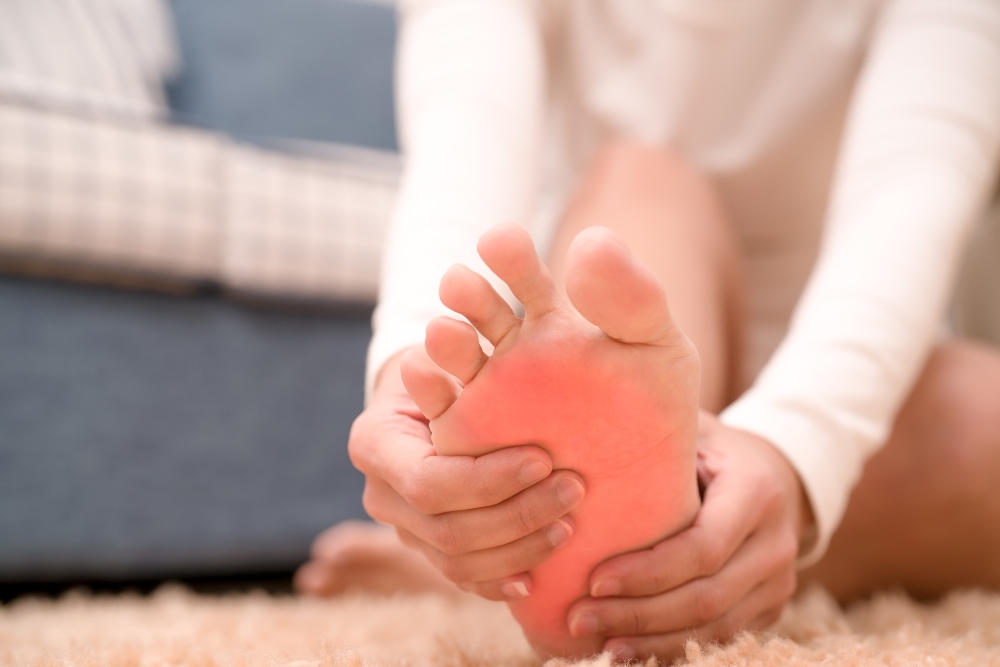Do you suspect your foot pain is related to injury to a tendon? There are five common forms of tendonitis, each affecting different regions of the foot: Achilles, tibial, flexor, peroneal, and extensor.
The good news is, with the right self-care, these injuries usually heal themselves over the course of a few weeks. Of course, there are exceptions— and we know what you need to treat each and prevent them from turning into chronic conditions.
Types of Foot & Ankle Tendonitis
Which type of tendonitis applies to you? Read through the common causes, symptoms and get the treatment you need, right away.

1. What is Achilles Tendonitis?
If you have pain above the back of your heel, especially when you stretch your ankle or stand on your toes, you may have the most common form of tendonitis, Achilles. If you play a sport or participate in an activity where you quickly speed up, slow down or pivot, this may be your culprit.
Achilles tendonitis is inflammation of the Achilles tendon, the largest tendon in your body. It stretches from the bones of your heel to your calf muscles and is the thing that lets you point your toes down or rise to your tiptoes.
If this tendon ruptured, your pain may be severe. In order to avoid this level of strain, an Achilles injury may involve months of resting, icing, compression, stretching and strengthening exercises.
2. What is (Posterior) Tibial Tendonitis?
Do you have pain in the inner part of your foot or ankle? If you recently suffered from an ankle sprain, you are more likely to have this tendon issue, Posterior Tibial Tendonitis, as opposed to others.
Your posterior tibial muscle attaches to the back of the shin bone, and this tibial tendon connects it to the bones of your foot. It attaches to the bone on the inner side of your foot, next to the arch, which is why this type of tendon problem usually affects the inside of your ankle.
There are four stages to the posterior tibial condition, progressing from some swelling and discomfort all the way to a deformity called adult acquired flat foot deformity (AAFD) and resulting rigid ankle issues. Catching this injury early and treating it with arch-supportive footwear, rest and anti-inflammatory medications can ease the recovery process and stop the injury from escalating into a chronic condition.
3. What is Peroneal Tendonitis?
Are you experiencing pain or swelling around the back of your ankle or when turning your foot in or out? If you have a tendency to roll your foot outward during activity— or, if you play a sport that involves repetitive ankle motion— you may be suffering from Peroneal Tendonitis.

Everyone has two peroneal tendons in each leg. One attaches to the outside of your foot at the base of the little toe, while the other stretches underneath your foot and attaches to the inside of your arch.
Overuse or an unhealed injury could cause Peroneal Tendonitis, or simply having high arches or imbalanced muscle in your lower limbs. Long-term stress to this tendon can cause the formation of scar tissue, actually weakening your tendons.
4. What is Flexor Tendonitis?
Does it hurt when you bend your big toe? It might be because of a strain to your flexor hallucis longus tendon, AKA Flexor Tendonitis.
Your flexor tendon runs from your lower leg, past the inside of your ankle to the base of your big toes. If your shoes are too big, you have flat foot or participate in a sport where you push off your toes a lot— like dancing or sprint running— you could have irritated this tendon.
Icing, massaging and stretching your toes can help to reduce swelling and give your body time to heal naturally, but for those still actively participating in routine athletic practices, this could turn into a chronic condition without proper advisement and care.
5. What is Extensor Tendonitis?
If you spend a lot of time on your feet or are wearing shoes that are too tight, you may have pain across the top of your foot. This could be a sign of Extensor Tendonitis.
There are two main extensor tendons that connect to your foot, the hallucis longus and the extensor digitorum— the first responsible for your ability to raise your big toe and the second for your other four. Both run down the front of the ankle, across the top of your foot.
Just like all the other forms of tendonitis we discussed, the best thing you can do to allow your extensor tendons to heal is to rest, massage the area and ice it periodically. In severe cases, you may need steroid injections in tandem with physical therapy.

How Can I Get Relief?
Each of these types of tendonitis requires different treatment methods, especially depending on the severity of the strain.
A podiatrist can work with you to find the best approach, but typically you can find relief through guided stretches, icing and resting or taking anti-inflammatory medications. In some cases, custom-fitted orthotics will help you to control the motion of your foot and ankle, to prevent your tendonitis from reoccurring.
When to See a Doctor
If you try the above relief methods and are still experiencing pain after a week of mindful care, it’s probably best to see a podiatrist.
A trained professional will be able to determine the tendon at fault and help to create a custom treatment plan— so your acute injury doesn’t progress into a long-term, chronic issue.
We’ve Got Your Diagnosis!
Depending on your injury, other conditions could have very similar symptoms as tendonitis. For example, you might assume your heel pain is an injury to your Achilles tendon, but really, it could be a sprain or a condition called Plantar Fasciitis. Or, runners, in particular, could have one of these injuries or conditions.
Don’t play guessing games. Our team at Foot & Ankle Group can help you put a name to your problem and advise you on the best path to recovery.
Give us a call at 239.936.5400 to make an appointment, today.
Categorized in: Blog